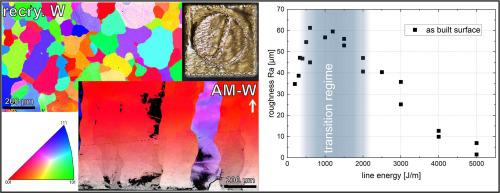Nuclear Materials and Energy ( IF 2.3 ) Pub Date : 2021-07-22 , DOI: 10.1016/j.nme.2021.101046 D. Dorow-Gerspach 1 , A. Kirchner 2 , Th. Loewenhoff 1 , G. Pintsuk 1 , T. Weißgärber 2 , M. Wirtz 1

|
Tungsten is an outstanding material and due to its properties like highest melting point and tensile strength of all natural metals and its high thermal conductivity it is a prime candidate for being used in very harsh environments and for challenging applications like X-ray tubes or as plasma facing material (PFM) in fusion reactors. Unfortunately, high brittle to ductile transition temperature and hardness represent a great challenge for classic manufacturing processes. Additive manufacturing (AM) of tungsten could overcome these limitations and resulting design restrictions. However, AM of tungsten also poses challenges in particular related to the production of material of high density and mechanical stability. Using a selective electron beam melting and a base temperature of 1000 °C of the powder, we were able to produce tungsten with a theoretical density of 99 % without the need of any post-treatment like a second melting step or a redensification by e.g. hot isostatic pressing (HIP). The surface morphology, microstructure, hardness, thermal conductivity and stability against severe transient heat loads were investigated with respect to the relevant building parameters and compared with recrystallized standard W. Besides simple test geometries also more sophisticated ones like monoblocks were successfully realized illustrating the potential of AM for fusion.
中文翻译:

电子束熔化法增材制造高密度纯钨
钨是一种出色的材料,由于它具有所有天然金属的最高熔点和抗张强度以及高导热性等特性,它是用于非常恶劣的环境和具有挑战性的应用(如 X 射线管或等离子体)的主要候选材料聚变反应堆中的饰面材料 (PFM)。不幸的是,高脆韧转变温度和硬度对经典制造工艺来说是一个巨大的挑战。钨的增材制造 (AM) 可以克服这些限制和由此产生的设计限制。然而,钨的增材制造也带来了挑战,特别是与高密度和机械稳定性材料的生产有关。使用选择性电子束熔化和 1000 °C 的粉末基础温度, % 无需任何后处理,如第二次熔化步骤或通过例如热等静压 (HIP) 进行的再致密化。研究了相关建筑参数的表面形貌、微观结构、硬度、热导率和对严重瞬态热负荷的稳定性,并与再结晶标准 W 进行了比较。 除了简单的测试几何形状外,还成功实现了更复杂的几何形状,例如整体式,说明了AM 用于融合。











































 京公网安备 11010802027423号
京公网安备 11010802027423号